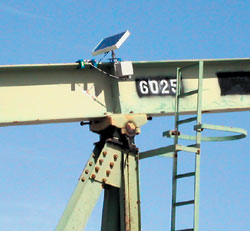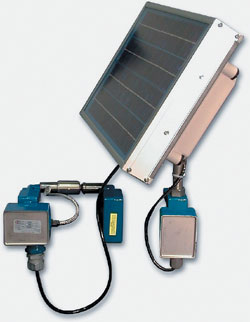|
| |
|

By Petroleum Technology Transfer Council |
Integrated rod-pump controller cuts operating costs
Use of a rod-pump controller reduces pumping time and fluid pound, which results in power cost savings while still maintaining total output
Randal Klimitchek, Phoenix Hydrocarbons Operating Co., Dayton, Texas, and Karl Sakocius, eProduction Solutions Inc., Houston
Phoenix Hydrocarbons Operating Co. agreed to beta-test the new iBEAM rod-pump controller (RPC) on one of its low-productivity wells in Esperson Dome field near Dayton, Texas. The field has 120 rod-pumped wells that lift fluids from depths of 2,000 to 4,000 ft. Sixty of these wells operate on timers, and one is controlled by an iBeam RPC, Fig. 1. This well produces 6 bopd with 50% water cut. The 2-in. by 1.5-in. by 10-ft THD pump produces 22°API gravity oil from a depth of 2,300 ft.
 |
Fig. 1. The RPC unit is shown installed on a stripper well operated by Phoenix Hydrocarbons Operating Co. in East Texas.
|
|
Prior to installing the RPC, a timer set by the operator controlled the well, which pumped 12 hr/day. Using the RPC, which has been on the well seven months, pumping time has been reduced to only 3 hr/day without decreasing production. Because electricity costs about $.06/kW, the power cost savings amount to approximately $125/month. Considering the power cost savings alone, payout of the RPC expense, including installation, will be less than 16 months.
Additional, future savings are expected from reducing the number of repairs and workovers. Not enough time has passed to measure the savings from reduced failures. However, instances have been cited where RPCs cut the failures by 20% to 50%, dependent upon current operating conditions. In many cases, the price for a single repair job is sufficient to cover the RPC installation’s entire cost.
SURPRISING BETA TRIAL RESULTS
Phoenix agreed to partner with eProduction Solutions (eP) in field-testing the RPC during the late stages of product development. By participating in field testing at this stage, Phoenix gained the benefits of RPC usage, plus input into the final stages of product development. As this article went to press, the iBEAM was set to be released commercially.
More importantly, Phoenix was able to cut the electrical operating cost for this over-pumped well. Over-pumping a well will increase the number of failures. Without an RPC to recognize an empty pump and shut the well down, the well would continue to run long after lowering the fluid level below the pump. This results in “fluid pound,” which exerts excess stress on the pump, the rods, the tubing and the pumping unit, when the downhole pump’s traveling portion strikes fluid in the pump barrel.
The RPC reduces fluid pound frequency, allowing the well to run longer with fewer repairs. Monthly output actually goes up, because of reduced downtime. In addition, the reduced failure rate saves repair costs for operators.
When the well ran on a timer, it was over-pumped, because adjusting timers is a guessing game. This is a common practice for low-productivity wells – the operator adjusts the run time and then monitors well production. By increasing and decreasing run time, the operator eventually determines the minimum run time required for a maximum production rate. This process is difficult and time-consuming. Often, the optimal daily run time is never reached, especially when fields have dynamic fluid levels caused by various injection methods.
Changing well conditions compound the difficulty of this trial-and-error method. Using an RPC assures that the fluid level is lowered only to the pump level, and then it is shut off (idle time) until the fluid level rises to a point that allows the well to begin a new run cycle. The controller optimizes the restart time by readjusting idle time, based on the recent pump cycle history. Proper pump cycles keep the fluid level low, which reduces back pressure on a low-pressure reservoir, thus allowing maximum inflow.
As regards the Phoenix well, it was already over-pumped, so back pressure was at a minimum. The benefit brought to this well by the RPC was an ability to keep the well pumped off without over-pumping.
MAKING RPCs INEXPENSIVE
RPCs have been proven to cut electrical costs, minimize well failures, reduce workover costs and increase production. Unfortunately, most operators are reluctant to install them on low-productivity wells because of capital, installation and maintenance costs.
With its unique, self-contained design, Fig. 2, the iBEAM unit addresses each of these cost concerns by using proven load and position technology without requiring the traditional cabling and trenching associated with most RPCs. Because of its wireless design, the controller eliminates installation and maintenance costs associated with cables to the load cell and position sensor. The controller’s compact design provides additional savings, resulting in a high-tech unit that costs less than $2,000, or about half the cost of prior industry technology.
 |
Fig. 2. The controller is a totally self-contained unit that contains SCADA communications, solar power supply, load and position sensors, and integrated intelligence to remotely operate a well or wells.
|
|
Embedded radio technology is used to send control commands to the well’s motor starter relay, as well as communicate operational data to a host-based software system for remote monitoring and detailed analysis. The radio also provides data to a handheld device for operators to use while visiting the wellsite.
The controller uses advanced strain gauge technology for load measurement, and accelerometer technology for measuring polished rod position. This has proved historically to be the most accepted method to control rod-pumped wells. The RPC generates a dynamometer card that is used to identify pump-off conditions and other potential load-based problems that can occur in a rod-pumped well. Technology used in this unit has been proven on over 25,000 wells around the world. In addition, the collection and storage of surface dynamometer cards and other valuable information, such as daily run time, provide the data needed to perform sophisticated analysis with realtime or non-real time software analysis tools.
FUTURE PLANS
Phoenix is looking at expanding RPC usage for its other rod-pumped wells. The firm is also evaluating radio systems for remote well monitoring. Both dedicated-band and spread-spectrum radio systems are being evaluated. Each has its own set of benefits that need to be measured against the field’s unique attributes.
With communications and a host-based control and analysis system in place, Phoenix will have the capability to respond in a timely fashion to changing well conditions. Workers will be able to fine-tune RPC performance as needed and instantly recognize problems with the wells. In addition, Phoenix will have the opportunity to use its workforce more effectively by knowing which wells are in need of immediate attention. This is a benefit to smaller producing companies, where efficient workforce use is critical. 
THE AUTHORS
|
| |
Randal Klimitchek is production manager at Phoenix Hydrocarbons Operating Co. in Dayton, Texas. He is responsible for oil and gas production at the Esperson Dome, Martha, Hardin and Stowell fields, in Liberty and Chambers Counties, Texas. He has worked 12 years in the industry, primarily in the areas of oil and gas production, personnel supervision, drilling, exploration and workover programs, and overseeing daily operations in the field.
|
|
Karl Sakocius is vice president of marketing for eProduction Solutions, Inc. (eP), based in the Houston area. He directs marketing management, strategic planning and company communications. He is spearheading market expansion of the company’s automation and analysis solutions for production optimization. Karl has more than 10 years of experience in the high-technology industry. Before eP, he held positions at CASE Services, Inc., and Platinum Technology, Inc. He is the recipient of the Energy Telecommunications and Electrical Association’s (ENTELEC) Silver Scribe Award. He holds a BS degree in education from West Chester State University, and an MBA from the University of Houston. He can be contacted at karl.sakocius@ep-solutions.com
|
| |
|
|




